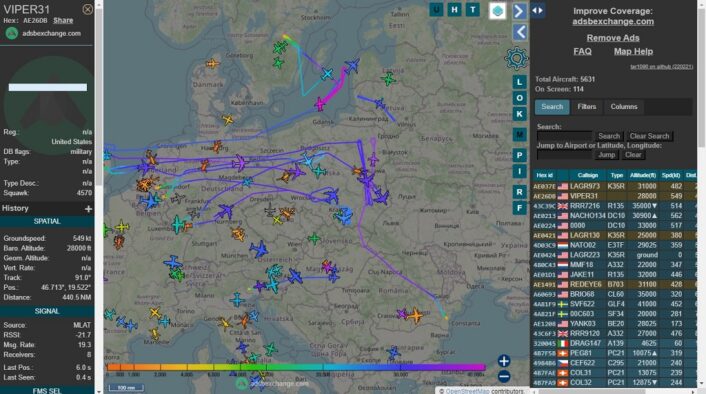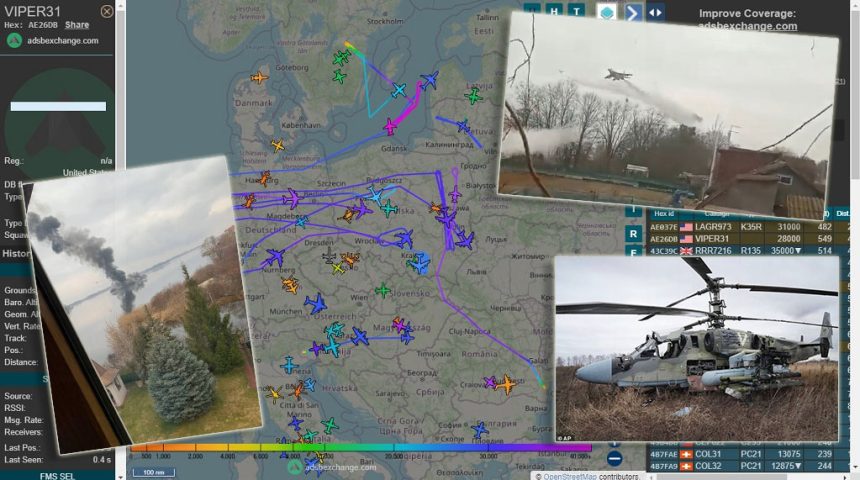OSINT (Open Source Intelligence) analysis on social media platforms and flight tracking websites provides insights into the highly dynamic situation with many new details every minute.
As it is being widely reported, Russia launched full scale military operations on Ukrainian soil early on the morning on Feb. 24, 2022. Minutes after the Russian president Putin announced the order to begin the operations in the Dombass region, missile and air strikes begun to hit key targets all over the country, crippling the Ukrainian military installations. Initial strikes have been reported as catastrophic for the country, with both civilian and military losses.
As expected, cyber warfare and information warfare are a big part of this operation, with cyber attacks against the Ukrainian networks and waves of fake reports that make it more complicate to understand the real situation on the ground. We will try our best to filter out all the dubious news and be as accurate as possible while reporting on these terrible events. Let’s now try to understand better what happened so far.
The first stage of the operation was a wave of cyber attacks to non-kinetically disrupt Ukrainian network infrastructures. Yesterday, such attacks targeted, among the others, some of the Ukraine institutional websites, like the Foreign Ministry, as well as multiple banks. Ukrainian authorities said this week they had seen online warnings that hackers were preparing to launch major attacks on government agencies, banks and the defense sector.
This attack follows another wave of DDoS (Distributed Denial of Service) attacks that caused about 70 government websites to crash last week. A destructive “data-wiping” software has also been found circulating on hundreds of computers in Ukraine, according to reports. Ukraine and the United States blamed Russia for the attacks, which are believed to be orchestrated by the Russian Main Intelligence Directorate (GRU).
⚠️ Per NOTAM, flights by civil aircraft are now restricted inside Ukraine. pic.twitter.com/vJf6MCWXks
— Flightradar24 (@flightradar24) February 24, 2022
Last night, hours before troops begun to move in, NOTAMs UKBV A0576/22 and URRV U0104/22 appeared online, signalling that something was about to happen soon. The former was issued by Ukraine, stating that flights of civil aircraft within its airspace are restricted due to potential hazard for civil aviation, while the latter was issued by Russia, closing a portion of the airspace along the border with eastern Ukraine.
Also, an urgent message of the Russian Ministry of Defence warned about high risks for the flight safety of civil aircraft associated with use of weapon and military equipment effective from 00:45 UTC on February 24, requesting the Ukrainian air traffic control to take urgent measures to stop flights. As mentioned in the Conflict Zones Information Bulletin (CZIB) issued by EASA, the NOTAMs are valid until May 24.
At 04.50LT, Putin announced on TV that he had ordered a military operation in the Donbass in a rather threatening message. During the address, he accused NATO of continuing to expand during the last 30 years despite Russian protests and concerns, meeting proposals for agreement between the two parties with “either cynical deception and lies or attempts at pressure and blackmail”, in an “insolent manner of talking down from the height of their exceptionalism”.
Then, Putin continued his address with an accusation against all NATO operations of the last 30 years, from the former Yugoslavia to the most recent in Lybia and Syria, which he defined as illegal aggressions based on fake facts by the Western “empire of lies”. This is just the introduction, but we will now jump to the real announcement. You can find the entire transcript of the message on the Kremlin’s website.
“The people’s republics of Donbass have asked Russia for help”, said Putin announcing the imminent attack. “In this context, in accordance with Article 51 (Chapter VII) of the UN Charter, with permission of Russia’s Federation Council, and in execution of the treaties of friendship and mutual assistance with the Donetsk People’s Republic and the Lugansk People’s Republic, ratified by the Federal Assembly on February 22, I made a decision to carry out a special military operation.”
“The purpose of this operation is to protect people who, for eight years now, have been facing humiliation and genocide perpetrated by the Kiev regime”, he continued. “To this end, we will seek to demilitarise and denazify Ukraine, as well as bring to trial those who perpetrated numerous bloody crimes against civilians, including against citizens of the Russian Federation. It is not our plan to occupy the Ukrainian territory. We do not intend to impose anything on anyone by force.”
After urging Ukrainian military forces to “refuse carrying out their criminal orders” and to lay down their weapons, he sent a very clear message against anyone willing to help Ukraine and interfere with the ongoing Russian plans, which many are seeing as a threat of furious retaliation against NATO should the alliance decide to intervene:
“I would now like to say something very important for those who may be tempted to interfere in these developments from the outside. No matter who tries to stand in our way or all the more so create threats for our country and our people, they must know that Russia will respond immediately, and the consequences will be such as you have never seen in your entire history. No matter how the events unfold, we are ready. All the necessary decisions in this regard have been taken. I hope that my words will be heard.”
Jesus. This is where some of the strikes have been reported. It’s all Ukraine not just the east. And Kyiv too pic.twitter.com/C6ZHqt1wzk
— Alec Luhn (@ASLuhn) February 24, 2022
Minutes after this long address, cruise and ballistic missiles started raining all over Ukrainian territory. According to reports, Tu-95 and Tu-160 bombers launched Kh-101 and Kh-505 cruise missiles, ground forces launched Iskander short-range tactical ballistic missiles and naval forces launched Kalibr long-range cruise missiles.
The bombers were shown exercising with the same cruise missiles during last week’s drills as well as heard on radio during the attacks, while the Iskander launchers were seen moving near the border in preparation for the attack. Kalibr missiles were shown in multiple videos on social medias while flying at low altitude towards their targets. The missile strikes were followed by a wave of air strikes, as well as artillery barrages with MLRS systems.
Following the first strikes, Moscow announced the destruction of the Ukrainian air forces, air defenses and naval forces. Later, the reports became more specific by stating that 74 military objectives have been destroyed, including 11 airfields, with the Pentagon estimating more than 100 missiles launched. Images coming in shows all kind of military targets being struck, including barracks, checkpoints, radars, aircraft on the ground, as well as debris of the weapons used, like the Kh-31-series missiles. However, many civilian targets were also hit in the process.
A Ukrainian radar site destroyed in strikes today pic.twitter.com/H36DcryGE1
— Intel Air & Sea (@air_intel) February 24, 2022
Clearer photos. Definitely remnants of a Kh-31-series.
If its the Kh-31PD variant, then this war marks its first combat use. If its the Kh-31P variant, then this marks its first documented use in combat (its use against Georgia in 2008 isn’t confirmed).https://t.co/3U08zjPy39
— Guy Plopsky (@GuyPlopsky) February 24, 2022
Among the airfields attacked there is Hostomel airport, near Kyiv, which is home of aircraft manufacturer Antonov and the NATO SALIS (Strategic AirLift International Solution) program.
More footage of the Air Assault. I suspect Russian Spetsnaz will take control of the Gostomel Airport within the day. pic.twitter.com/Kud2HeKobi
— Kemal (@kemal_115) February 24, 2022
Unconfirmed reports mention the possible destruction of the An-225 Mriya, the world’s heaviest aircraft, which was on the ground in one of the hangars that caught fire during the attack.
Home of Antonov Aircraft – which has implications for worldwide support of Antonov Airlines cargo fleet. #avgeek https://t.co/e8DUERb0DA
— Tim Robinson (@RAeSTimR) February 24, 2022
Ukrainian authorities claimed the destruction of a number of aircraft and missiles, with Russia immediately denying those claims. Photos and videos, however, seems to confirm that some Russian helicopters have been indeed shot down or at least damage to the extent that they had to crash land. Videos also show Russian helicopters being extremely aware of the MANPADS threat and launching preemptively salvos of flares.
Visually-confirmed Ukrainian equipment losses so far consist of:
1x BRM-1K AFV
4x BTR-4 IFV
1x Kozak-2 IMV
5x Radar
1x An-26 transport aircraft
12 Trucks
— Oryx (@oryxspioenkop) February 24, 2022
#war The footage was shot near Vyshgorod, 20 km from 🇺🇦Kiev. pic.twitter.com/ug8x7Viu4a
— Capt(N) (@Capt_Navy) February 24, 2022
One of the videos about downed helicopters shows a heavily damaged Ka-52 that was forced to land northwest of Kyiv after being supposedly hit by a missile. Interestingly, the national markings, bort number and Russian Aerospace Forces insignia appears to be removed, replaced instead by a white “V”. Something similar was noticed also on ground forces vehicles in the past few days, which swapped their insignias for white “Z” and “O” symbols.
Note the Ka-52 has had #Russia national markings and bort number removed – replaced with a white ‘V’ https://t.co/oGpRWjvTBP pic.twitter.com/4kbTtQGQ3E
— Joseph Dempsey (@JosephHDempsey) February 24, 2022
Ground forces started moving in from Belarusian, Russian and Crimean borders, marking the beginning of heavy clashes with Ukrainian forces. Ukrainian soldiers are putting to use the weapons received in the last few weeks by the US, UK and other European countries, destroying a number of vehicles and reportedly taking prisoners.
Along with fake images and clips not related to the current situation in Ukraine, footage supposedly showing Ukrainian jets trying to attack Russian forces has also emerged:
MiG-29 FULCRUM fighter. Horrible video at https://t.co/dsK8JsnuTD pic.twitter.com/d8bmn6p91u
— H I Sutton (@CovertShores) February 24, 2022
While this was taking place, we noticed through flight tracking websites (which, by the way, experienced server overloads due to the huge number of visits) that the Intelligence, Surveillance and Reconnaissance assets, which were usually operating over Ukraine and Crimea, pulled back and positioned themselves mainly over Poland, Romania and the Black Sea. Multiple RC-135s, E-3 AWACS, an E-8C JSTARS and the Army’s ARTEMIS were all on station collecting data.
That’s the first time I see an RQ-4 Global Hawk reposition from 🇺🇦Ukraine to the Black Sea/Crimea the long way around, west of Moldova, rather than over Southern 🇺🇦Ukraine.
🇺🇸09-2039 #FORTE12 pic.twitter.com/CCG8lD8eq9
— Gerjon | חריון (@Gerjon_) February 24, 2022
We are still working hard on increasing the capacity, but the very big international interest generate 10-20 times higher traffic than normally, which is hard to handle.
— Flightradar24 (@flightradar24) February 24, 2022
In addition to these aircraft, multiple tankers have also been sent on station to provide air-to-air refueling to both the ISR assets and numerous fighters which were flying Combat Air Patrols (CAP) near the borders, some of which visible like a couple of F-16s from Aviano which were patrolling over Romania. Two B-52 bombers were also sent to the area, with one orbiting over Poland and the other one over Sweden for some hours.
The amount of mil flights tracking on @ADSBexchange over Poland and the Baltic region at 11.30UTC was pretty astounding. pic.twitter.com/LBqK71uRKz
— The Aviationist (@TheAviationist) February 24, 2022
Today can be considered one of the busiest days in a long time on flight tracking websites, with the huge quantity of aircraft visible, while at least as many aircraft were operating without transmitting Mode-S or ADS-B data (or at least non encrypted data). It should be noted, however, that all this aircraft being visible is no coincidence: if they are transmitting in the clear they want to be seen.










